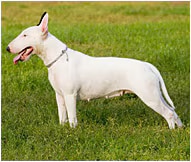They are stocky and muscular and come in two varieties: standard and miniature sizes. The standard version reaches about 22 inches in height and a maximum of about 60 pounds (27 kilograms). The miniature version is a maximum of about 14 inches high and weighs up to about 33 pounds (15 kilograms). The most distinctive physical feature of the Bull Terrier is its head, which is egg-shaped and flat on top. The eyes are small, dark, and close-set. The ears are pointy. The body is broad and the back short and strong. Bull Terriers have a medium-length tail.
The Bull Terrier's coat is short and dense and is white, black, brindle, red, fawn or tri-colored. The dogs are considered average shedders. They live about 10 to 12 years.
Bull terriers are gentle, affectionate and playful with family members. They also are loyal pets that will guard the family. As with any large or tough breed, proper precautions around strangers, children, and other animals is essential.
If not given enough exercise and attention from the owners, Bull terriers can be destructive.
Because the breed is powerful and some members may have aggressive tendencies, Bull Terriers must be obedience trained. They must also be carefully socialized from a young age. Socialization requires frequent supervised exposure to other people and pets in the neighborhood. With proper socialization and training, Bull Terriers make great family pets. However, they probably are not a good choice for novice dog owners, nor are they generally recommended for households with other pets or irresponsible children.
Bull terriers must be exercised daily in a fenced-in yard or with walks on leash and should not be permitted to run free, even if trained and socialized. Because of their stocky build, care must be taken not to overfeed as they can easily become obese.
Bull terriers were developed in England during the 19th century. Around 1835, a cross between the old English terrier and the bulldog produced the Bull Terrier. Later crosses to the Spanish Pointer; even later, to the white English terrier and Dalmatian, produced a stylish, tough, white dog. In the mid 1800s, the white version of the breed, known as "white cavaliers," became a favorite pet among gentry. Crosses to the Staffordshire Bull Terrier reintroduced color around 1900.
Today, Bull Terriers are gentler than their ancestors but are still strong, fearless dogs. They are primarily family pets, but are not suitable for many families.
Adopt a pet. Change a life.
Are you prepared to adopt a pet? Use these tools to make sure you are ready for the commitment.
Adopt a pet. Change a life.
Are you prepared to adopt a pet? Use these tools to make sure you are ready for the commitment.






















